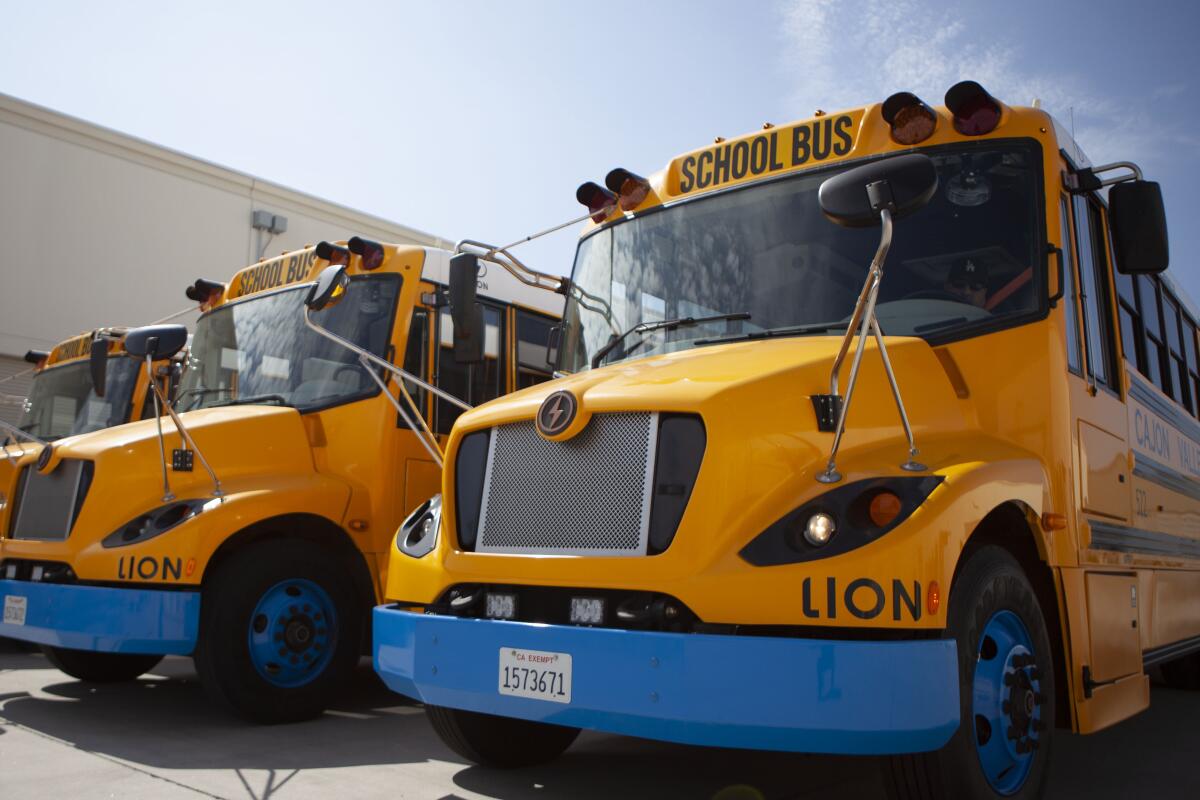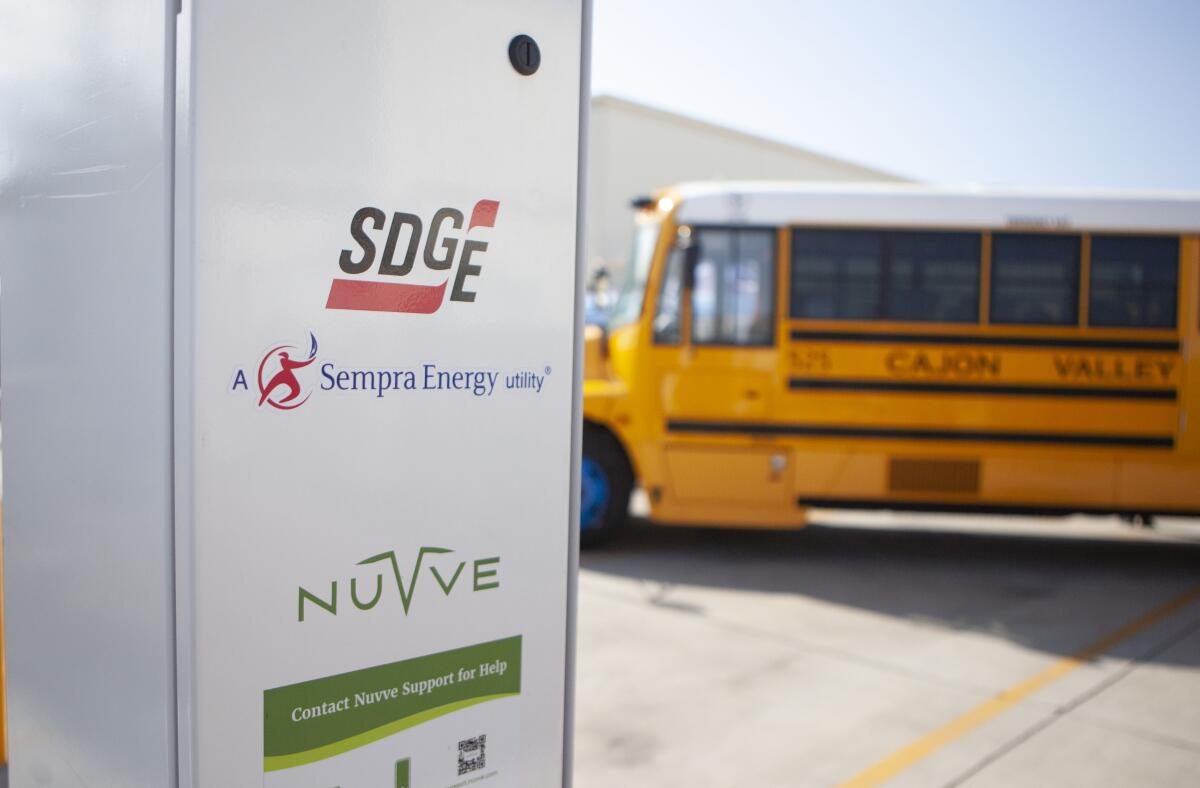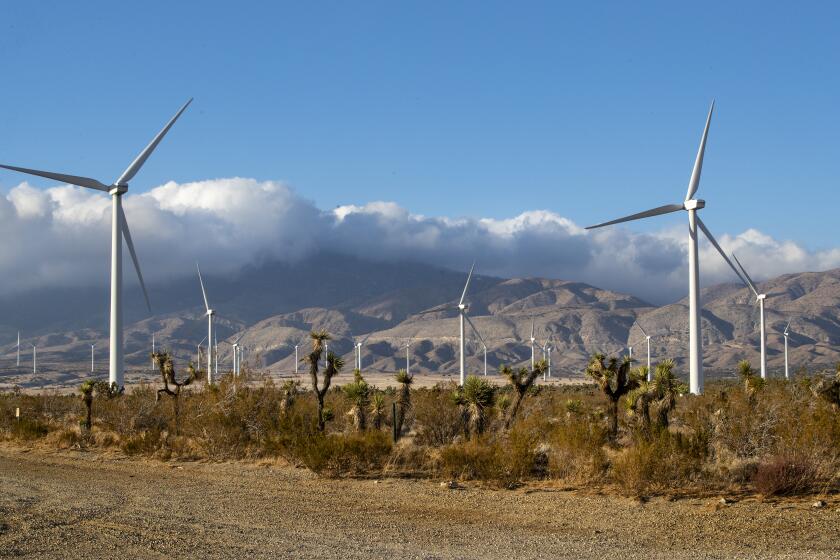How eight school buses are helping during power shortages: They’re transporting electrons

- Share via
A fleet of electric-powered school buses in El Cajon can send electricity back to California’s grid, thanks to first-of-its-kind technology developed by a San Diego company and a partnership with San Diego Gas & Electric.
And soon other school districts in the area will be able to do the same.
For the record:
6:06 p.m. Aug. 5, 2022A previous version of this article said this was the first vehicle-to-grid project in the U.S. It is the first in Southern California.
“These buses are like storage on wheels,” said Gregory Poilasne, chief executive of Nuvve, a technology company that specializes in advancing what’s called vehicle-to-grid projects.
Nicknamed V2G for short, the bidirectional technology enables electric vehicle batteries that charge up during the day when solar energy is abundant on California’s power system to then discharge emission-free energy back to the electric grid when it is needed the most.
In the case of the Cajon Valley Union School District, its fleet of eight all-electric school buses earlier this month successfully deployed the V2G technology as part of a pilot project in collaboration with Nuvve and SDG&E. As part of a five-year effort, the utility installed eight 60-kilowatt direct current fast chargers in the school district’s bus yard in El Cajon.
This is the first V2G project to come online in Southern California.
The controversial proposal would reshape how business is done on the California power grid.
“This is another distributed energy resource that’s mobile, that’s on the road,” said Miguel Romero, SDG&E’s vice president of energy innovation. “There’s a significant amount of capacity in these batteries.”
Manufactured by Lion Electric, the Cajon Valley buses have battery capacity of as much as 210 kilowatt-hours. That’s five times more than a typical electric car.
Scott Buxbaum, the school district’s assistant superintendent of business services, said the buses typically charge overnight when electricity prices are low. After the buses pick up and drop off students and drivers complete other chores, the batteries quickly get recharged and can then send electricity back to the grid.
“We can charge a bus in two to three hours from fully drained” using the fast chargers, Buxbaum said Tuesday at a news conference at the school district’s transportation offices. “That’s really important to have a fast-charging process.”
California’s electric system is particularly under stress during “net demand peak” — a crucial period when solar production wanes as the sun goes down but demand stays high, especially in the summertime, because people keep their air conditioners running and turn on their appliances after work.
With its bidirectional chargers up and running, Cajon Valley can take part in another pilot program the California Public Utilities Commission recently established.
Climate change spurred Friday’s unanimous vote by the Los Angeles City Council.
In an effort to reduce the risk of power outages when the grid is stressed, an Emergency Load Reduction Program in SDG&E’s service territory pays business customers $2 per kilowatt-hour if they are able to export power to the grid or reduce their usage during energy emergencies.
Discharging electricity from the buses, therefore, can put some money into the school district’s pocket.
Buxbaum said it’s too early to tell how much revenue that would translate to, but the money will be shared with Nuvve in an arrangement that will see the tech company take care of maintaining the charging stations for eight years.
“Any savings we have goes back to the classrooms,” Buxbaum said.
The technology is coming soon to the Ramona Unified School District, where eight bidirectional charging stations have been installed, and to the San Diego Unified School District, where at least three stations are poised to go online.
Nuvve’s Poilasne said school buses are excellent candidates to deploy V2G technology. Their large batteries enable them to send energy to the grid when needed but the buses will still have enough stored power to keep operating when the school district needs them.
“We need to make sure we are keeping the right ranges so that [we] are not deteriorating the battery of the vehicle,” Poilasne said.

The program at Cajon Valley was approved along with SDG&E’s Power Your Drive for Fleets program that builds charging stations and other infrastructure to take medium- and heavy-duty trucks that are powered by gasoline or diesel and replace them with electric vehicles.
The programs, approved by the California Public Utilities Commission, are funded by the rates paid by SDG&E customers. The utility estimates the Cajon Valley pilot program to be about $1 million.
SDG&E’s Romero said sending electricity to the grid via V2G technology “defers additional capacity investments and that ultimately benefits everybody.”
California policymakers have set a goal to derive 100% of the state’s electricity from carbon-free sources by 2045, if not sooner, and Gov. Gavin Newsom two years ago issued an executive order banning the sale of new gasoline-powered passenger cars by 2035.
Here are 25 bills dealing with renewable energy, electric cars and the power grid.
As for the school buses themselves, it appears the Cajon Valley Union School District got a bargain.
All-electric school buses typically list for nearly $400,000, but Buxbaum estimated various state and federal grants absorbed 95% of the costs to acquire the district’s fleet of eight.
The U.S. Environmental Protection Agency and the California Energy Commission combined to pay nearly all of the costs of five buses. Two others were largely covered by a grant from the California Air Resources Board, and the energy commission picked up the tab for the eighth bus.
“With school district budgets being tight, we rely heavily on those grants to make this project work,” Buxbaum said.
More to Read
Inside the business of entertainment
The Wide Shot brings you news, analysis and insights on everything from streaming wars to production — and what it all means for the future.
You may occasionally receive promotional content from the Los Angeles Times.














